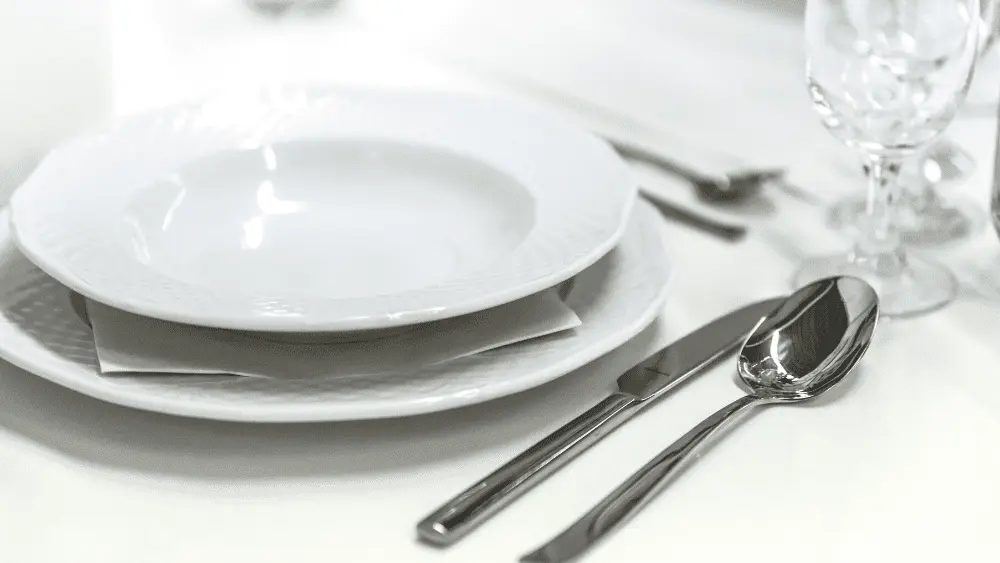
If you’ve ever set a table
for the holidays or a simple Sunday night supper and wondered, “Am I doing this right?” this article is
for you! Everybody knows the fork goes on the left side of the dinner plate — right?!
— but from there, many of us don’t know where to go.
NewHomeSource has put together seven tips help you master the table setting like a pro.
We’ve also included the NewHomeSource holiday playlist at the end of the article, so you can enjoy all the fun holiday vibes!
Step 1: Table Matters
Before setting down dishes
or flatware, consider what the table itself looks like. If it’s wood, you
probably won’t want to cover it up with a tablecloth, or even a placemat.
“Let the wood stand out,”
says Sybrandt Windell, the food and beverage director at the five-star luxury Acqualina Resort & Spa and The Estates at
Acqualina in Sunny Isles Beach, Florida. “It works well with the rustic
look that’s very popular at the moment, and when paired with earthy elements, it can be very elegant.”
If your table is covered
with glass, you may want to protect it from cracks by placing a tablemat
between the glass and a tablecloth. “This will also keep the noise level down,
as all that glass clinking can get very noisy,” Windell says.
Also consider how many people you plan to have at the table, and
make sure everyone has ample elbowroom. At least a foot and a half between
chairs is considered adequate.
Step 2: The Foundation
Decide whether you’ll use
a placemat, a tablecloth, or both. Most people turn to placemats for informal
meals and tablecloths with chargers for more formal events, but there are no
hard and fast rules when it comes to either. “There are times when the decor
may call for using both at the same time,” Windell says. Again, keep in mind
that if you’re looking to minimize sound, a placemat works wonders.
Step 3: Decode the Decor
Once you know what you’ll be serving, choose décor that complements the items on the menu (or at least doesn’t clash with it). Delicate dishes call for delicate china, perhaps a cream plate with a thin rim of rose gold, while heavier meals look best on sturdier dishware, such as Fiestaware.
“Keep centerpieces low, so
that everyone can easily see and talk to each other around the table,” Windell
says. “Less is usually more.”
In fact, try placing several
smaller accents on the table instead of one massive centerpiece. “Uneven
numbers look better than pairs,” Windell says. “It provides a better flow to
the eye and creates a nice table silhouette.”
If your meal takes place
after 3 or 4 p.m., weave in candlelight whenever possible, even if it’s just a few
short votives or elegant taper candles. Candlelight provides a soft, warm glow
that’s great for both formal and informal gatherings.
Be careful not to fill the
table with too many small décor items, especially those placed on top or next
to each place setting. Guests have to move them to use the tableware, and they
often don’t know exactly where to put them so they’re out of the way, which can
be awkward. You can also try placing them above every other place setting so the extra touches are visible to everyone but
not in anyone’s way.
Step 4: Plate Primer
Now you’re ready to plate each setting. Start with a charger if
you’re going for a formal look (forgo it if your meal is more casual). Add a main
course plate with a smaller plate on top for salad or side dishes. Place a
soup bowl on top of the salad plate if the menu calls for it. Whether your meal
is formal or informal, a side dish for bread and butter should always go above
and to the left of the place setting.
If guests will be serving
themselves, choose
serving dishes that are the right size and temperature to pass around. Avoid
anything that might be hard to carry with one hand. “I recommend dividing each
side dish across two or three plates and placing them around the table so that
everything is within reach to everyone,” Windell says.
Step 5: Drink Decoder
Too
many glasses at each setting can end up looking messy. “You don’t want it to look
like a tasting with a bunch of glasses,” Windell warns. Start
with a glass for water and one for wine and place them both above and slightly to
the right of each place setting. The general rule is to place the larger or
taller glass in the back.
Most
experts no longer adhere to rigid rules about the types of glasses you use.
“When glasses are different sizes and styles, they’re more interesting to look
at and make the most of the space,” adds Windell. If your meal will have wine
pairings, place the glasses in the order they will be used, so that the first
is closest to the place setting.
If
you’re not pairing wines but you think guests may switch from red to white wine
or vice versa, add just one extra glass at each setting. For any guest who chooses
not to drink wine or opts to hold on to their pre-dinner cocktail, do a quick
sweep of the table after the first course to remove the extra glass.
Step 6: Flatware Flare
Famed etiquette expert Emily Post’s FORKS acronym
still applies when it comes to placing flatware in the right position. Starting
from the left, F is for fork. For formal meals opt for both a salad fork and a
dinner fork and place the former first, so it’s farthest from the plate. The letter O represents the shape of the plate, which is always in the
center. Place the knife (K) to the right with the blade facing the plate. Next
to the knife should be the spoon (S) The R? Well, it just wouldn’t be a good
foodie acronym without it!
Place a butter knife across the bread plate horizontally
and if you plan to serve dessert at the table, add a small spoon above the
plates facing the same direction.
When serving multiple courses, you will need more
flatware available to guests. Also consider any extra flatware the menu calls
for, such as an oyster fork (this would go to the right of the spoon, the only
time a fork is ever placed on that side). Keep in mind having both a fork and
spoon makes pasta much easier to eat. If you opt to include a pasta spoon,
place it to the right of the soupspoon, or in lieu of it.
Step 7: Napkin Know-How
Where the napkin goes and how it’s folded has to do with preference and décor. “A flat fold or small square on top of the salad plate is perfectly acceptable,” Windell says. Also popular is what’s known as the candle fold, whereby the napkin stands in the center of the setting, on top of the plate, making a great impression when guests arrive at their seat. If you’re serving soup, fold the napkin into a flat square or rectangle and place it to the left of the plate, under the fork. Napkin rings also can be a great accent to tie the décor to each setting. If you opt for those, the napkin should go on top of the salad plate or soup bowl, whichever is on top.
Whatever you do, remember that table setting may be an art but there is no perfectly right or downright wrong way to do it anymore, just general guidelines. At the end of the day, nothing beats a delicious meal enjoyed in great company.
The NewHomeSource Holiday Playlist

Ana Connery is former content director of Parenting, Babytalk, Pregnancy Planner and Conceive magazines as well as parenting.com.
While editor in chief of Florida Travel & Life magazine from 2006-2009, she covered the state’s real estate and home design market as well as travel destinations.
She’s held senior editorial positions at some of the country’s most celebrated magazines, including Latina, Fitness and Cooking Light, where she oversaw the brand’s “FitHouse” show home.
Ana’s expertise is frequently sought after for appearances on “The Today Show,” “Good Morning America” and CNN. She has interviewed the country’s top experts in a variety of fields, including U.S. Secretary of Education Arne Duncan and First Lady Michelle Obama.
 Home Style Guide: Victorian Homes
Home Style Guide: Victorian Homes